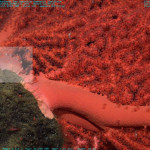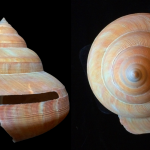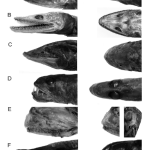If you would understand anything, observe its beginning and its development. –Aristotle
To understand the biogeography of the modern deep sea, we must examine the history of the ocean floor and the establishment of deep-sea fauna. The paleoceanography of the deep-sea is an account of intense fluctuations in temperature, oxygen, and circulation. In the past ~55mya, since the Eocene/Paleocene boundary, the deep sea cooled nearly 15˚C. A major cooling event is also evident in the Mid-Cenozoic at the Oligocene/Eocene boundary ~34 mya. Little is known of deep seafloor temperatures prior to 100 mya given the paucity of deep-sea sediments older than the Cretaceous. Apparent is there have been major shifts in deep ocean circulation driven by two different processes leading to density differences between water masses. In an excellent review on the implications of ocean circulation on the age of the deep-sea fauna, Horne (1999) contrasts two ocean types of the past, those dominated by thermohaline circulation (THC) driven by temperature-induced density differences at the poles resulting in cold deep water and halothermal circulation (HTC) driven by salinity-induced density differences in equatorial regions resulting in warm saline deep water. During HTC, circulation is reduced, as density differences tend not to be as great as during THC.
In addition to differences between deep-water temperature during THC and HTC, the two states differ greatly in oxygen concentrations. Due to poorer circulation and poorer ventilation, along with reduced carrying capacity for dissolved oxygen and increased oxygen demand of organisms resulting from higher temperatures, HTC states experience much lower oxygen concentrations than THC states often resulting in wide-spread deep-water anoxic events. Since the Oligocene/Eocene transition the deep sea has been dominated by THC conditions of high oxygen concentrations, a “two layered” ocean, and thermohaline circulation. Indeed, large-scale anoxic events have been absent since the Paleocene. However, prior to the Oligocene/Eocene in the HTC phase dating back to the Triassic, deep-water anoxia was frequent and often widespread.
I mention all of this because most of the recent dialogue on deep-sea faunal origins focuses on timing and effects of anoxic events. However, earlier workers in the late 19th century viewed the deep-sea as buffered against ongoing climate change and extinctions. This combined with early finds of “living fossils”, led many to believe the deep sea a fossil refuge comprised mainly of Pre-Cambrian and Cambrian relics. This “tenacious idea” is largely dispelled with findings that Paleozoic relics are rare, the presence of more primitive forms in shallow water, and evidence of recent and impressive radiations of some deep-sea fauna.
The remaining hypotheses about the origins include much of the rest of the Phanerozoic, with the exceptions of the Jurassic and Triassic. Most of these hypotheses center on “extinction and replacement” of the deep-sea fauna and thought to be triggered by severe anoxic events. Indeed, the idea of anoxic-triggered replacement has led to a new “tenacious idea”, the Mid-Cenozoic Replacement hypothesis. In this scenario, the deep-sea fauna is relatively contemporary dating back to the last major anoxic event at the Oligocene/Eocene boundary. However, several authors have questioned the ability of anoxic events to “reset” the deep-sea fauna.
Modern deep-sea faunas appear to actually represent a composite of clades with multiple originations throughout the Phanerozoic. For example, benthic deep-sea foraminifera genera represent 5% originating in the early Paleozoic, 45% from the pre-Cretaceous, and the remaining 50% from the Eocene. Whereas Asellota, dominating the deep-sea isopods, originated as late as the Jurassic with a subsequent and impressive deep-sea radiation, flabelliferan isopods conform to a relatively recent colonization in the Cenozoic. Bivalves and gastropods are thought to originated in the late Ordovician, with known fossil assemblages dating to the Lower Cretaceous. In contrast deep-sea octopods, represent relatively recent origins dating back to 30 mya with a subsequent radiation at 15 mya. Similarly all modern deep-sea ostracods arose in the Oligocene and later. Holasteroid echinoids participated in at least four deep-sea invasions, three in the Late Cretaceous and one as early as the Miocene. The Late Cretaceous also gave rise to the stylaserid corals.
One final question remains. What is the site of invasion of shallow taxa into the deep sea? In general, the locations fall into the 1) Antarctic, 2) Mediterranean, and 3) multiple source locations. In the first two scenarios, locations of isothermal conduit is though to be key to migration. In later, scenario shallow-water migration is thought to occur unimpeded and occurred globally. Evidence of the amazing pressure and temperature tolerances of embryos and larvae of marine invertebrates supports this idea supports the later. However, evidence exists that several clades did originate form Antarctic fauna , although there is also evidence that Antarctic fauna in parts derives from the deep sea.
References
Allen, J. A. 1978 Evolution of the deep sea protobranch bivalves. Philosophical Transaction of the Royal Society of London B 284, 387-401.
Ameziane, N. & Roux, M. 1997 Biodiversity and historical biogeography of stalked crinoids (Echinodermata) in the deep sea. Biodiversity and Conservation 6, 1557-1570.
Balmford, A. 1996 Extinction filters and current resilience: the significance of past selection pressures for conservation biology. Trends in Ecology & Evolution 11.
Bensen, R. H. 1975 The origin of the psychrosphere as recorded in changes of deep-sea ostracode assemblages. Lethaia 8, 69-83.
Clague, D., Paduan, J. B. & Davis, A. S. 2009 Widespread strombolian eruptions of mid-ocean ridge basalt. Journal of Volcanology and Geophysical Research 180, 171-188.
Clarke Jr., A. H. 1962 On the composition, zoogeography, origin and age of the deep-sea mollusk fauna. Deep-Sea Research 9, 229-306.
Davis, A. S., Clague, D., Bohrson, W. A., Dalrymple, G. B. & Greene, H. G. 2002 Seamounts at the continental margin of California: A different kind of oceanic intraplate volcanism. GSA Bulletin 114, 316-333.
de Forges, B. R., Koslow, J. A. & Poore, G. C. B. 2000 Diversity and endemism of the benthic seamount fauna in the southwest Pacific. Nature 405, 944-947.
Distel, D. L. & Baco, A. R. 2000 Do mussels take wooden steps to deep-sea vents? Nature 403, 726.
Gage, J. D. & Tyler, P. A. 1991 Deep-Sea Biology: A Natural History of Organisms at the Deep-Sea Floor. Cambridge: Cambridge University Press.
Glover, A. G. & Smith, C. R. 2003 The deep-sea floor ecosystem: current status and prospects of anthropogenic change by the year 2025. Environmental Conservation 30, 219-241.
Grassle, J. F. 1989 Species diversity in deep-sea communities. Trends in Ecology and Evolution 4, 12-15.
Hessler, R. & Thistle, D. 1975 On the place of origin of deep-sea isopods. Marine Biology 32, 155-165.
Hessler, R. R. & Sanders, H. L. 1967 Faunal diversity in the deep sea. Deep-Sea Research 14, 65-78.
Horne, D. J. 1999 Ocean circulation modes of the Phanerozoic: implications for the antiquity of deep-sea bnethonic invertebrates. Crustaceana 72, 999-1018.
Jablonski, D. 2005 Mass extinctions and macroevolution. Paleobiology 31, 192-210.
Jablonski, D. & Bottjer, D. J. 1991 Environmental patterns in the origins of higher taxa: the post-Paleozoic fossil record. Science 252, 251-253.
Jablonski, D., Sepkoski Jr., J. J., Bottjer, D. J. & Sheehan, P. M. 1983 Onshore-offshore patterns in evolution of Phanerozoic shellf communities. Science 22, 1123-1125.
Jacobs, D. K. & Lindberg, D. R. 1998 Oxygen and evolutionary patterns in the sea: Onshore/offshore trends and recent recruitment of deep-sea faunas. Proceedings of the National Academy of Science 95, 9396-9401.
Jeppsson, L. 1990 An oceanic mode for lithological and faunal changes tested on the Silurian record. Journal of the Geological Society, London 147, 663-674.
Kiel, S. & Little, C. T. S. 2006 Cold-seep mollusks are older than the general marin mollusk fauna. Science 313, 1429-1431.
Knudsen, J. 1979 Deep-sea bivalves. In Pathways in Malacology (ed. S. van der Spoel, A. C. van Bruggen & J. Lever), pp. 195-224. Utrecht: Springer.
Levin, L. A. 2003 Oxygen minimum zone benthos: adaptation and community response to hypoxia. Oceanography and Marine Biology: an Annual Review 41, 1-45.
Levin, L. A., Etter, R. J., Rex, M. A., Gooday, A. J., Smith, C. R., Pineda, J., Stuart, C. T., Hessler, R. R. & Pawson, D. L. 2001 Environmental influences on regional deep-sea species diversity. Annual Review of Ecology and Systematics 32, 51-93.
Linder, A., Cairns, S. D. & Cunningham, C. W. 2008 From offshore to onshore: multiple origins of shallow-water corals from deep-sea ancestors. PLoS One 3, e2429, 1-5.
Lipps, J. H. & Hickman, C. S. 1982 Origin, age, and evolution of antarctic and deep-sea faunas
. In The Environment of the Deep Sea, vol. 2 (ed. W. G. Ernst & J. G. Morin), pp. 324-356. Englewood Cliffs, NJ: Prentice-Hall, Inc.
McClain, C. R. & Barry, J. 2009 Habitat heterogeneity, biogenic disturbance, and resource availability work in concert to regualte biodiversity in deep submarine canyons. Ecology in press.
McKinnery, M. L. 1997 Extinction vulnerability and selectivity. Annual Review of Ecology and Systematics 28, 495-516.
Menzies, R. J. & Imbrie, J. 1958 On the antiquity of the deep-sea bottom fauna. Oikos 9, 192-210.
Mosely, H. N. 1880 Deep-sea dredging and life in the deep sea. III. Nature 21, 591-593.
Raupach, M. J., Cristoph, M., Malyutina, M. & Wägele, J.-W. 2009 Multiple origins of deep-sea Asellota (Crustacea: Isopoda) from shallow waters revealed by molecular data. Proceedings of the Royal Society B.
Raupach, M. J., Held, C. & Wagele, J.-W. 2004 Mutliple colonization of the deep sea by the Asellota (Crustacea: Peracarida: Isopoda). Deep-Sea Research II 51, 1787-1795.
Raupach, M. J., Malyutina, M., Brandt, A. & Wägele, J.-W. 2007 Molecular data reveal a highly diverse species flock within the munnopsoid deep-sea isopod Betamorpha fusiformis (Barnard, 1920) (Crustacea: Isopoda: Asellota) in the Southern Ocean. Deep-Sea Research II 54, 1820-1830.
Rogers, A. D. 2000 The role of the oceanic oxygen minima in generating biodiversity in the deep sea. Deep-Sea Research II 47, 119-148.
Ruhl, H. A. 2008 Community change in the variable resource of the abyssal northeast Pacific. Ecology 89, 991-1000.
Ruhl, H. A. & Smith, K. L. 2004 Shifts in deep-sea communtiy structure linked to climate and food supply. Science 305, 513-515.
Sanders, H. L. 1968 Marine benthic diversity: a comparative study. American Naturalist 102, 243-282.
Sepkoski Jr., J. J. 1991 A model of onshore-offshore changes in faunal diversity. Paleobiology 17, 58-77.
Sibuet, M. & Olu, K. 1998 Biogeography, biodiversity and fluid dependence of deep-sea cold-seep communities at active and passive marignes. Deep-Sea Research II 45, 517-567.
Smith, A. B. & Stockley, B. 2005 The geological history of deep-sea colonization by echinoids: roles of surface productivity and deep-water ventilation. 272, 865-9.
Smith, C. R. 1985 Food for the deep sea: utilization, dispersal, and flux of nekton falls at the Santa Catalina Basin floor. Deep Sea Research 32, 417-422.
Smith, C. R. & Baco-Taylor, A. R. 2003 Ecology of whale falls at the deep-sea floor. Oceanography and Marine Biology Annual Review 41, 311-354.
Strugnell, J. M., Rogers, A. D., Prodöhl, P. A., Collins, M. A. & Allcock, A. L. 2008 The thermohaline expressway: the Southern Ocean as a centre of origin for deep-sea octopuses. Cladistics 24, 853-860.
Van Dover, C. L. 2000 The Ecology of Deep-Sea Hydrothermal Vents. Princeton, NJ: Princeton University Press.
Vetter, E. W. & Dayton, P. K. 1998 Macrofaunal communities within and adjacent to a detritus-rich submarine canyon system. Deep-Sea Research II 45, 25-54.
Villalobos, F. B., Tyler, P. A. & Young, C. M. 2006 Temperature and pressure tolerance of embryos and larvae of the Atlantic seastars Asterias rubens and Marthasterias glacialis (Echinodermata: Asteroidea): potential for deep-sea invasion. Marine Ecology Progress Series 314, 109-117.
Waelbroeck, C., Labeyrie, L., Michel, E., Duplessy, J. C., McManus, J. F., Lambeck, K., Balbon, E. & Labracherie, M. 2001 Sea-level and deep water temperature changes derived from benthic foraminifera isotopic records. Quaternary Science Reviews 21, 295-305.
Wilson, G. D. F. 1999 Some of the deep-sea fauna is ancient. Crustaceana 72, 1019-1030.






4 Replies to “The Origins of Deep-Sea Fauna”
Comments are closed.